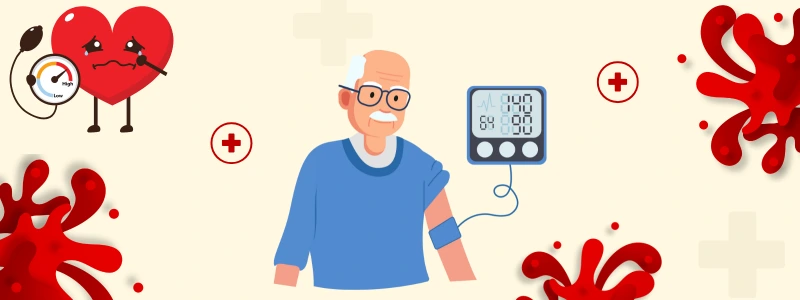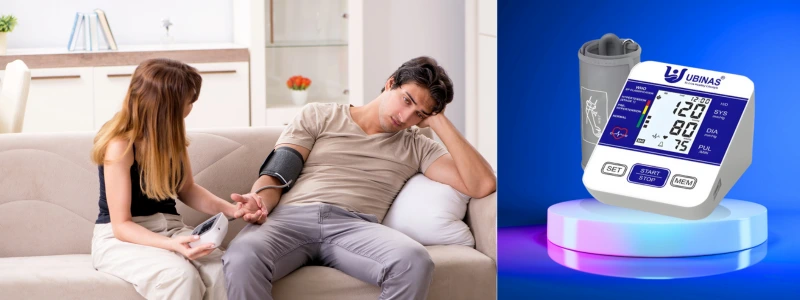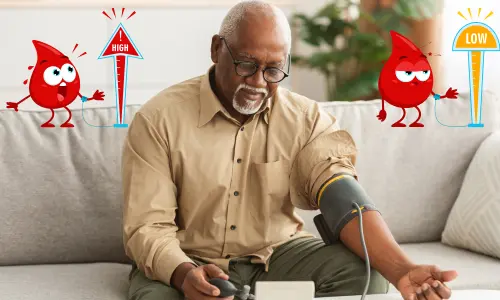Blood pressure is the force of blood pushing against the walls of your arteries as your heart pumps it around your body. It’s measured in two numbers:
- Systolic Pressure (the top number): The pressure when your heart beats and pumps blood.
- Diastolic Pressure (the bottom number): When your heart rests between beats.
A normal blood pressure reading is around 120/80 mmHg. If your numbers are consistently higher or lower than this, it could indicate a problem.

What is High Blood Pressure (Hypertension)?
High blood pressure, or hypertension, occurs when the force of blood against your artery walls is too high. It’s often called a “silent killer” because it usually has no symptoms but can lead to serious health problems like heart disease, stroke, and kidney damage.
- High Blood Pressure Range: 140/90 mmHg or higher.
What is Low Blood Pressure (Hypotension)?
Low blood pressure, or hypotension, happens when the force of blood against your artery walls is too low. While it’s less common than high blood pressure, it can cause dizziness, fainting, and fatigue.
Low Blood Pressure Range: Below 90/60 mmHg.
How to Control High Blood Pressure
If you have high blood pressure, here are some steps to help manage it:
- Exercise Regularly: Aim for 30 minutes of moderate exercise, like walking or swimming, most days of the week.
- Reduce Salt Intake: Too much salt raises blood pressure. Avoid processed foods and limit added salt.
- Eat a Heart-Healthy Diet: Focus on fruits, vegetables, whole grains, and lean proteins. The DASH diet is highly recommended.
- Limit Alcohol: Drinking too much alcohol can raise blood pressure. Stick to moderate amounts (1 drink per day for women, 2 for men).
- Manage Stress: Practice relaxation techniques like deep breathing, meditation, or yoga.
Take Medications: If your doctor prescribes medication, take it as directed.
How to Control Low Blood Pressure
If you have low blood pressure, here are some tips to manage it:
- Stay Hydrated: Drink plenty of water throughout the day to prevent dehydration, which can lower blood pressure.
- Increase Salt Intake: Unlike high blood pressure, a slightly higher salt intake can help raise low blood pressure. Consult your doctor first.
- Eat Small, Frequent Meals: Large meals can cause a drop in blood pressure. Eating smaller meals more often can help.
- Avoid Alcohol: Alcohol can lower blood pressure further, so it’s best to avoid it.
- Wear Compression Stockings: These can help improve blood flow and reduce symptoms of low blood pressure.
Stand Up Slowly: To prevent dizziness, take your time when moving from sitting to standing.

Exercises for High Blood Pressure
If you have high blood pressure, the best exercises are those that are moderate and consistent. These help strengthen your heart and improve blood flow without overstraining your body. Examples include:
- Walking: A simple, low-impact exercise that’s great for beginners.
- Swimming: A full-body workout that’s easy on the joints.
- Cycling: Outside or on a stationary bike, cycling is excellent for heart health.
- Yoga: Combines physical activity with stress relief, which is great for lowering blood pressure.
- Strength Training: Light to moderate weightlifting can help, but avoid heavy lifting.
Avoid: High-intensity exercises like sprinting or heavy weightlifting, as they can temporarily spike blood pressure.
Exercises for Low Blood Pressure
If you have low blood pressure, the goal is to improve blood circulation and prevent sudden drops in blood pressure. Focus on gentle, low-impact exercises that don’t involve rapid changes in position. Examples include:
- Walking: A steady, moderate-paced walk can help improve circulation.
- Leg Raises: While lying down, lift your legs to improve blood flow.
- Yoga: Gentle poses like the legs-up-the-wall pose can help with blood flow.
- Stretching: Improves flexibility and circulation without overexertion.
- Tai Chi: A slow, flowing exercise that’s great for balance and circulation.
Avoid: Exercises that involve sudden movements or standing up quickly, as these can cause dizziness or fainting.

Using a Digital Blood Pressure Machine
A digital blood pressure machine is a simple, easy-to-use device that lets you check your blood pressure at home. Here’s how to use it:
- Sit Comfortably: Rest for 5 minutes before taking a reading. Sit with your back straight and feet flat on the floor.
- Wrap the Cuff: Place the cuff around your upper arm, following the instructions that come with your device.
- Start the Machine: Press the start button, and the machine will inflate the cuff and measure your blood pressure.
- Record the Reading: Note down your systolic and diastolic numbers, as well as your pulse rate if provided.
Tips for Accurate Readings:
- Avoid caffeine, smoking, or exercise 30 minutes before measuring.
- Take readings at the same time each day for consistency.
If you’re unsure about your readings, consult your doctor.
Why a Digital Blood Pressure Machine is Helpful
- Convenience: You can check your blood pressure anytime, anywhere.
- Track Progress: Regular monitoring helps you see if your lifestyle changes are working.
Early Detection: Spotting high or low blood pressure early can prevent serious health issues.
Conclusion
Whether you’re dealing with high or low blood pressure, managing it is key to living a healthy life. By eating right, staying active, and using a digital blood pressure machine to keep track of your numbers, you can take control of your health. Remember, small changes can make a big difference! If you’re concerned about your blood pressure, always consult your doctor for personalized advice. Stay healthy, stay happy!

